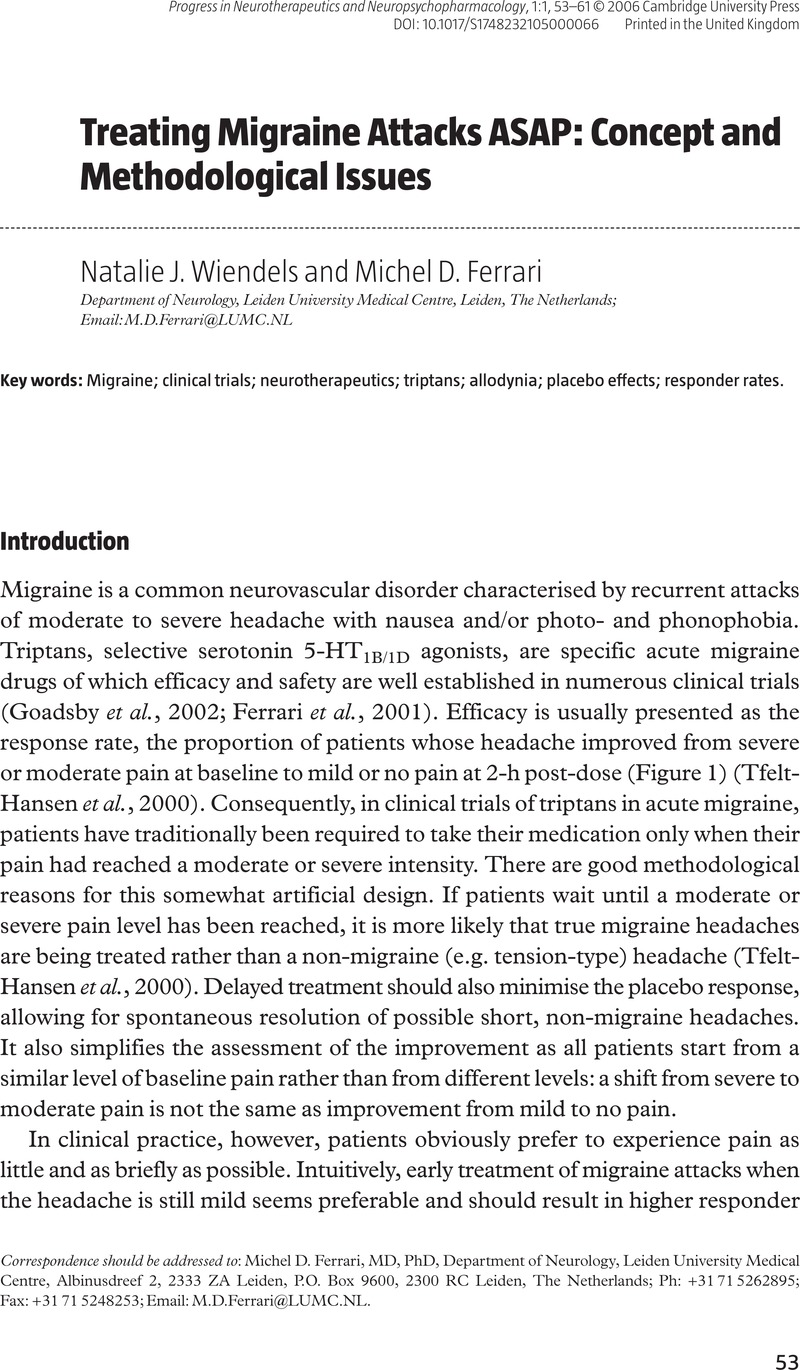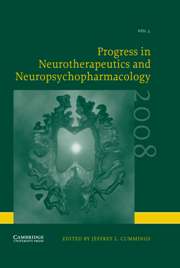No CrossRef data available.
Article contents
Treating Migraine Attacks ASAP: Concept and Methodological Issues
Published online by Cambridge University Press: 15 February 2006
Abstract
An abstract is not available for this content so a preview has been provided. Please use the Get access link above for information on how to access this content.

- Type
- Review Article
- Information
- Progress in Neurotherapeutics and Neuropsychopharmacology , Volume 1 , Issue 1 , January 2006 , pp. 53 - 61
- Copyright
- © 2006 Cambridge University Press
References
Bates, D., et al. (1994). Subcutaneous sumatriptan during the migraine aura. Sumatriptan Aura Study Group. Neurology, 44, 1587–1592.Google Scholar
Burstein, R., & Jakubowski, M. (2004). Analgesic triptan action in an animal model of intracranial pain: a race against the development of central sensitization. Annals of Neurology, 55, 27–36.Google Scholar
Burstein, R., Cutrer, M.F., & Yarnitsky, D. (2000). The development of cutaneous allodynia during a migraine attack clinical evidence for the sequential recruitment of spinal and supraspinal nociceptive neurons in migraine. Brain, 123, 1703–1709.Google Scholar
Burstein, R., Collins, B., & Jakubowski, M. (2004). Defeating migraine pain with triptans: a race against the development of cutaneous allodynia. Annals of Neurology, 55, 19–26.Google Scholar
Cady, R., et al. (2004). Randomized, placebo-controlled comparison of early use of frovatriptan in a migraine attack versus dosing after the headache has become moderate or severe. Current Medical Research and Opinion, 20, 1465–1472.Google Scholar
Cady, R.K., et al. (2000). Effect of early intervention with sumatriptan on migraine pain: retrospective analyses of data from three clinical trials. Clinical Therapeutics, 22, 1035–1048.Google Scholar
Diamond, S., & Freitag, F.G. (2004). Sumatriptan 6 mg subcutaneous as a successful treatment for migraine associated with allodynia. Neurology, 62, A149.Google Scholar
Diener, H.C., & Limmroth, V. (2004). Medication-overuse headache: a worldwide problem. Lancet Neurology, 3, 475–483.Google Scholar
Dowson, A.J., et al. (2004). Almotriptan improves response rates when treatment is within 1 hour of migraine onset. Headache, 44, 318–322.Google Scholar
Ferrari, M.D. (2004). Should we advise patients to treat migraine attacks early? Cephalalgia, 24, 915–917.Google Scholar
Ferrari, M.D. (2005). Should we advise patients to treat migraine attacks early: methodologic issues. European Neurology, 53 (Suppl. 1), 17–21.Google Scholar
Ferrari, M.D., et al. (2001). Oral triptans (serotonin 5-HT(1B/1D) agonists) in acute migraine treatment: a meta-analysis of 53 trials. Lancet, 358, 1668–1675.Google Scholar
Foley, K.A., et al. (2005). Treating early versus treating mild: timing of migraine prescription medications among patients with diagnosed migraine. Headache, 45, 538–545.Google Scholar
Goadsby, P.J., Lipton, R.B., & Ferrari, M.D. (2002). Migraine-current understanding and treatment. New England Journal of Medicine, 346, 257–270.Google Scholar
Klapper, J., et al. (2004). Benefits of treating highly disabled migraine patients with zolmitriptan while pain is mild. Cephalalgia, 24, 918–924.Google Scholar
Mathew, N.T. (2003). Early intervention with almotriptan improves sustained pain-free response in acute migraine. Headache, 43, 1075–1079.Google Scholar
Mathew, N.T., Kailasam, J., & Meadors, L. (2004). Early treatment of migraine with rizatriptan: a placebo-controlled study. Headache, 44, 669–673.Google Scholar
Olesen, J., et al. (2004). No effect of eletriptan administration during the aura phase of migraine. European Journal of Neurology, 11, 671–677.Google Scholar
Pascual, J., & Cabarrocas, X. (2002). Within-patient early versus delayed treatment of migraine attacks with almotriptan: the sooner the better. Headache, 42, 28–31.Google Scholar
Plosker, G.L., & McTavish, D. (1994). Sumatriptan. A reappraisal of its pharmacology and therapeutic efficacy in the acute treatment of migraine and cluster headache. Drugs, 47, 622–651.Google Scholar
Scholpp, J., et al. (2004). Early treatment of a migraine attack while pain is still mild increases the efficacy of sumatriptan. Cephalalgia, 24, 925–933.Google Scholar
The Subcutaneous Sumatriptan International Study Group. (1991). Treatment of migraine attacks with sumatriptan. New England Journal of Medicine, 325, 316–321.Google Scholar
Tfelt-Hansen, P., et al. (2000). Guidelines for controlled trials of drugs in migraine: second edition. Cephalalgia, 20, 765–786.Google Scholar




